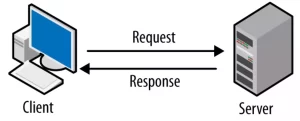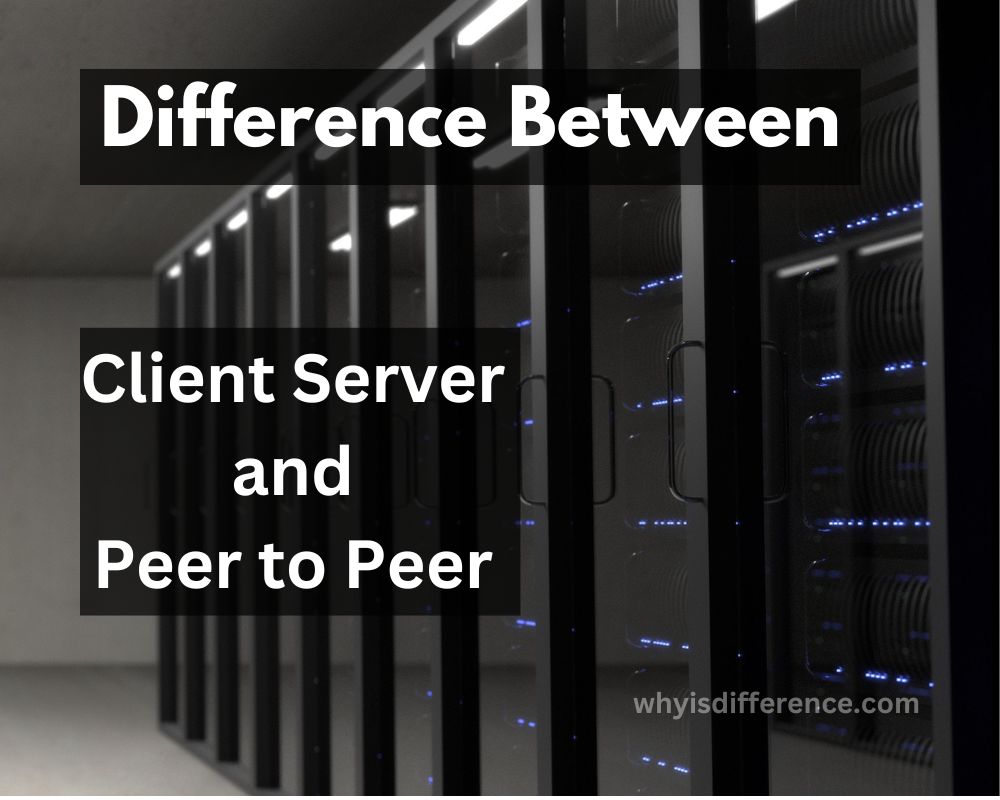Client Server and Peer to Peer architectures are two common network designs. Client-server divides tasks among servers while clients request services; clients and servers can communicate on different computer systems or even simultaneously. Meanwhile, with peer-to-peer architecture tasks are divided among peers who collectively form a network and share privileges and potential. Each participant makes available part of its resources such as disk storage space or bandwidth to the other participants in this arrangement.
What Is Client Server Architecture (CSA)

- An architectural style where workload and responsibility is divided among two entities – clients and servers. They communicate across networks to complete specific tasks or fulfill requests.
- Under a client/server architecture, clients are entities or programs that interact directly with users or request services or resources from servers. Clients include desktop applications, web-browsers, mobile applications or any device capable of creating networks.
- Servers are powerful computers or software applications that provide services and resources to their clients. A server can handle multiple requests at the same time from multiple clients at once and has the processing power and resources necessary to meet them all. They store data, calculate calculations and send back responses directly back to them – they offer clients whatever services they require!
- Under this architecture, communication between clients typically follows a request-response model. Clients define what resources or services they require, then send requests directly to servers.
- Client-Server Architecture brings many advantages, including central control and management (centralized), scalability and security. Furthermore, this structure facilitates easy maintenance, updates and resource allocation as well as complex system development by splitting functionality between clients and servers.
- Client-Server Architecture is crucial when designing and implementing systems requiring efficient and dependable communication between servers, and clients, to provide resources and services efficiently to users.
What is Peer to Peer Architecture?

- Peer-to-Peer Architecture (P2P), more commonly referred to as distributed computing, is an innovative model in which participants of a network – known as peers – act both as clients and servers within it. Each peer in this architecture has the capacity to request resources from others as well as to offer those resources directly.
- Peer to Peer architecture does not involve the control of a central server or authority; rather, peers communicate and interact directly among themselves in order to share and trade resources such as data files and processing power among themselves. Peers may join or exit at any time while also cooperating together in order to consume and provide resources as needed.
- Peer-to-peer architecture differs from client-server in that responsibilities for processing and storage are shared among peers rather than concentrated at one central server, which means each peer contributes their computing power, bandwidth and storage space to the network – creating redundancies and fault tolerance for greater resource sharing, redundancy and fault tolerance.
- Peer to Peer architecture allows communication among peers directly or via intermediate peers depending on its topology. Peers can connect and discover each other using various protocols and mechanisms such as Distributed Hash Tables, decentralized trackers or peer discovery protocols.
- Peer-to-peer architecture offers many advantages, such as decentralized control, self scaling and robustness. P2P networks can facilitate collaboration, sharing and prevent single points of failure while encouraging cooperation among its participants. P2P networks can also be utilized for file-sharing, content distribution, blockchain technology applications and decentralized applications.
- Peer-to-peer architecture is essential when designing systems with distributed resource sharing, collaborative capabilities, and self organizing abilities. This ensures resilient and scalable networks in which peers contribute towards overall performance and functionality of the system.
Importance of understanding the differences
It is essential to comprehend the differences between Client Server and Peer to Peer architectures for several reasons.
- Design and Development: Understanding the differences is essential in order to design and develop systems and applications using architectures of various styles, as it enables developers to make educated decisions regarding each style’s advantages and characteristics.
- Resource Management: Understanding architectural differences is vital to effective resource management. Client-Server architecture involves placing resources on servers, which requires careful planning for optimal scalability and performance optimization. When distributed among peers in peer-to-peer architectures, decentralized resource management becomes crucial.
- Scalability and Performance: Your architectural choice will have an effect on scalability. Client-Server Architecture offers central control with load balancing on dedicated servers to manage large installations while Peer-to Peer architecture allows distributed scaling as your network grows with more peers. Being aware of these differences will allow you to select an architecture suitable for future growth with optimal performance in mind.
- Security and Access Control: Client-Server architecture allows for centralized security measures and access control mechanisms while Peer-to Peer architectures differ by lacking centralized authority, thus creating unique challenges when it comes to trust among peers and resources sharing. It is vitally important that organizations understand these differences so as to implement appropriate measures and protect both systems and participants effectively.
- Use Case Suitability: Different use-cases and applications require either Client-Server or peer-to-peer architectures for optimal use, and understanding their differences can help identify which architecture best fits each scenario. Client-Server architecture works best when an application needs central data management or strict access controls while peer-to-peer architecture works better when an app requires decentralized data-sharing, fault tolerance or collaborative resource sharing.
The differences between Client Server and Peer to Peer architectures will enable designers, developers and architects to make more informed decisions, optimize performance and resource efficiency while implementing security measures, as well as select an apt architecture for specific use cases.
Client/Server Architecture (CPSA)
Client-Server computing is an essential concept in modern computing, underpinning how services, applications and resources are delivered over networks. Understanding its dynamic is vitally important for users, developers and architects alike; in this blog post we’ll examine its components, communication models, advantages and limitations in more depth.
Client-Server Architecture:
- Clients: Entities that interact with users.
- Servers: the Heroes Behind the Scenes
- Network: the Invisible Infrastructure
- Request-Response Model: At the core of client-server architecture lies an orderly exchange of requests and responses between client computers and servers. Find out how this communication model affects application functionality and user interaction.
- Client-Side Processors: Uncover how clients manage user interfaces, create presentations logically, request data or services from servers, and how client-side technology shapes user experiences.
- Server-Side Processing: Discover how servers power client requests by processing and receiving client requests, while exploring their processes – data retrieval, computation and response generation are among them.
- Characteristics and Advantages of Client-Server Architecture: Learn the benefits of centralized control through servers. They serve as a central hub for coordination, control and administration.
- Scalability and Performance: Learn how to utilize load balancing and scaling techniques so that servers can handle multiple requests from clients while providing optimal performance.
- Security and Access Control: Understand how security measures implemented on servers serve to enforce access controls, safeguard sensitive data and authenticate client clients.
- Limitations and considerations: Considerations regarding server availability, Take into account its impact on client operations when considering server unavailability.
- Cost and complexity: Evaluate the associated costs and complexity in setting up and maintaining servers, including any required expertise or specialization requirements.
- Single Point of Failure: Be wary of server failure risks, and take redundancy steps to mitigate those risks.
- Real-World Usecases and Applications: Uncover how client-server architecture plays out in various applications such as web applications, email servers, file servers and database management systems – see its impact in real life applications!
The Client/Server Architecture is at the core of modern computing, enabling efficient delivery and distribution of resources, applications, and services over networks. As technology progresses further, an understanding of this architecture becomes ever more vital to designing, developing, and using systems which capitalize on its power – so next time you visit a database or browse online remember that this framework makes everything possible!
Peer-to-Peer Architecture
Peer-to-Peer (P2P), an intriguing concept in distributed computing that allows participants to share and collaborate resources decentralized, is a compelling concept. Gaining an understanding of its complexities can lead to resilient and innovative systems; this blog post will take you on an journey to discover its essence, its components, communication models, advantages, limitations and real world applications.
- Peer-to-peer Architecture: 1.the Equal Participants, 2.Connected Peers Network, 3. Sharing Resources Is at the Core of Collaboration
- The Decentralized Collaboration Model: Discover the Decentralized Collaboration Model. Examine its unique dynamics of peer interaction.
- Peer Roles and Responsibilities: Learn about how each peer fulfills both client and server roles within a network, providing their computing power, storage capacity, or bandwidth to support its activities. Uncover resource consumption as well as contribution.
- Benefits of Peer-to-Peer Architecture: Explore the freedom and autonomy that Peer-to-Peer architecture affords participants, empowering them to operate autonomously without relying on a central governing entity.
- Resource Sharing and Collaborative Applications: Unlock the power of efficient resource sharing, distribution, and collaborative applications designed for scalability and fault tolerance.
- Reduce Single Points of Failure: Assess the robustness and reliability of Peer-to Peer architecture to reduce single points of failure risk. Without an centralized server to be relied upon for hosting services, chances of single point failure decrease dramatically.
- Considerations and Challenges: Analyze implications of decentralized environments, such as trust establishment, coordination, and maintaining consistency.
- Security and Trust: Explore the unique security challenges presented by Peer-to-Peer architecture, such as establishing trust through mechanisms such as trust establishing, identity verification and resources sharing security.
- Scalability and Performance: Investigate the obstacles to scaling as your network expands and implement strategies to overcome them.
- File Sharing: Discover how Peer to Peer architecture has revolutionized file sharing by providing efficient and decentralized distribution.
- Content Delivery: Discover how peer-to-peer networks can be leveraged to deliver content efficiently, reduce bandwidth costs, and enhance scalability.
- Decentralized Applications (DApps): Discover the power of Peer to Peer architecture to develop decentralized applications without an intermediary.
- Blockchain Technology: This distributed ledger employs peer-to-peer architecture for immutability and decentralized control.
Peer-toPeer architecture is an exciting and revolutionary approach to distributed computation, allowing resource sharing, decentralized collaboration and scalability. Understanding its components, communication models, advantages and challenges reveals its full potential as resilient collaborative systems harness the strength of equal participants – the cornerstone for decentralized innovation as technology evolves – moving us toward an age of collaboration and resource sharing without central authorities.
What is the difference between Client-Server and Peer to Peer Network Architectures?
Client-server systems distinguish clients and servers as separate entities while peers act both as service providers and consumers of services provided to clients by peers to peers systems. Client-server networks require a central file server and may cost more to implement; in comparison with peers to peer networks which rely solely on individual users managing security; client-server systems can scale as needed while peer-to-peer networks experience degradation as the number of nodes increases; therefore your chosen implementation environment will determine which option would work best.
| Aspect | Client-Server Architecture | Peer-to-Peer Architecture |
|---|---|---|
| Communication Model | Follows request-response pattern | Direct interaction between peers |
| Resource Management | Servers manage and provide resources | Peers contribute and share resources |
| Scalability | Scaling by adding more servers | Scaling by adding more peers |
| Performance | Load balancing across multiple servers | Increased load handling with more peers |
| Control | Centralized control and coordination | Decentralized autonomy |
| Security | Centralized access control and authentication | Trust establishment among peers, securing resource sharing |
Conclusion
The peer-to-peer and the client-server models are two different network structures. In a configuration that is client-server central servers control and supply resources to multiple clients, which allows for efficient resource utilization, central control, and scaling. In contrast, peer–to–peer networks share tasks and resources equally across the devices that are connected, encouraging decentralization and removing single sources of failure. While client-server is ideal for large-scale applications that require strong management, peer-to-peer is a good choice for smaller, less complicated networks that focus on autonomy and collaboration. The decision between these two is dependent on the specific needs and the size that the system.

